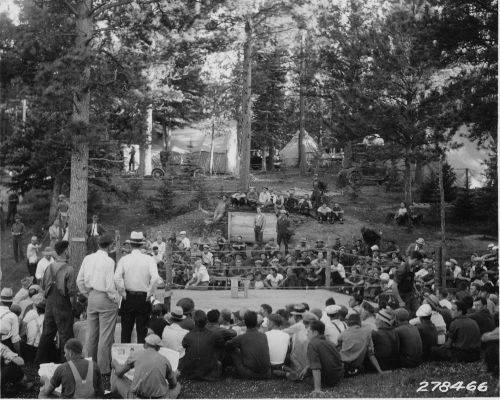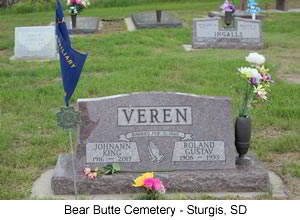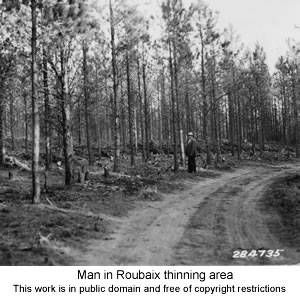Roland Gustav Veren
Sturgis, SD
1934-36, 792, Roubaix, F-6, Leader
1937, 791, Lightning Creek, F-14, USFS foreman
1938-39, 762, Camp Doran, F-23,
On January 9, 1934 I enrolled in Company 792, Camp F-6 (Roubaix), and was promoted to assistant leader March 1, 1934. We thinned timber and built a small dam with pick and shovel and wheel barrows.
After some leaders were discharged in September, I was promoted to leader on October 1, 1934. Our work then included building truck trails for fire suppression, timber thinning in overcrowded stands, roadside cleanup, and building Roubaix dam, which is now a fine recreation lake in the northern Hills.

For recreation we played "kittenball" and boxed. Boxing became quite competitive among the barracks. There were educational classes most every night and I attended all of them. Forestry foremen taught classes in forestry, watershed management, timber harvest for sustained yield, fire prevention and suppression, and stream maintenance for fishing and enhancing game habitat.
Before being discharged in the summer of 1936 to accept employment I was selected to take a civil service examination for appointment to the U.S. Forest Service. In January 1937 I received an appointment as junior assistant technician with a salary of $1,020 per year and was assigned to Camp Oreville near Hill City where I worked with an engineer making a profile for a girl scout camp and had a crew planting trees on burned over area.
In the spring of 1937 I transferred to Camp Lightning Creek west of Custer along with three other technicians who had been CCC enrollees and had taken the same examination I had. We were trained for timber cruising--mapping the types and age of trees. We four lived in temporary quarters--a 1-room prefab building at Minnekahta, 8 miles west of Hot Springs. There we worked on land acquisition and exchange. In this program the forest service traded isolated parcels of national forest land for privately owned land in order to consolidate the national forest into a block and reduce the number of small parcels of privately owned land within the boundaries of the forest. This work was known as cruising and included chaining and locating corners; mapping to show drainage, classes of timber, soil type, and land suitability; and computing the volume of board feet. The project was finished in August 1938 and our civil service jobs ended.
We were given a chance to go back into CCC camps as project assistants. I did, and went to Camp Doran, east of Custer, and then to a side camp at Horsethief Lake. Here I supervised a pine bark beetle control crew which located affected trees, then cut and burned them to kill the larvae.
On March 13, 1939 I was discharged to take over my mother's rented farm.
Personal Benefits
Now I would like to tell how my CCC and forest service experience helped me during the years since those "good old days."
I was just a poor country boy whose parents lived on a small rented farm. I worked for the neighbors when not needed at home. When the opportunity came to join the CCC and have $25 sent to my parents it was the best I could find.
I had always been at the very bottom of the ladder in work and in my social life, and I could hardly believe it when I was asked to be an assistant leader in the CCC. I could see where willingness to learn and do good work was paying off. After I was appointed leader at $45 per month I really gained confidence and my whole attitude towards life changed.
My experience in watershed management and development was to serve me well. When in 1946 I was able to borrow money and buy a ranch of my own, I put to good use much of what I had learned in the CCC concerning water development and land use. My ranching operations proved successful and my appreciation of soil and water grew each year. I had also learned the duties and responsibilities of leadership partly due to my taking part in the class of public speaking and debate while in the CCC.

After we organized the Black Hills Conservancy Sub-district I became chairman and served in that capacity for many years. I also helped organize the Black Hills Resource Conservation and Development District (RC & D) and served on its executive council for many years.
In 1971 Governor Kniep appointed me to the South Dakota Conservation Commission for a 6-year term. I also served on the Board of Water and Natural Resources for many years, representing the Black Hills sub-district. I also served as chairman of our local water shed committee.x
Roland G. Veren was born Aug. 31, 1908 and died Jan. 20, 1993.
xDerschied, Lyle A. "The Civilian Conservation Corps in South Dakota, 1933-1942." Brookings, SD, South Dakota State University Foundation Press, 1986. No longer in print. Available at some libraries but may not be checked-out.
Do you have additional information about Roland Veren
We would like to included it. Please write or email us at History "at" SouthDakotaCCC "dot" org.







